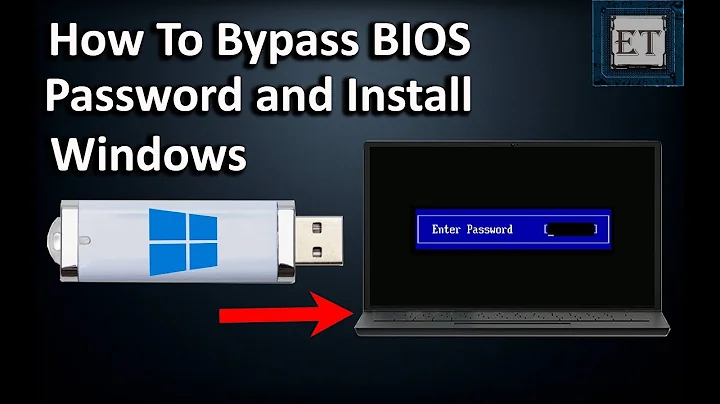Install Windows without admin rights and a locked bios
It is absolutely necessary to reset the BIOS password.
In most cases, to remove the BIOS password one must disassemble the laptop and locate either the CMOS jumper or the CMOS battery. With the battery and AC adapter disconnected, remove the CMOS battery or if there is a CMOS jumper (3 prongs with jumper on 2 often nearby the CMOS battery), move that jumper to the CLR or Clear position, hold the power button until the power cycles on and off and or hold it continuiously for 10+ seconds. After, replace the CMOS battery or reset the CMOS jumper to the normal setting (not CLR). You can now replace the battery and plug in the AC Adapter. If you don't want to deal with the hassle of dissasembly, using a backdoor password put in by the Motherboard's Manufacturer is appropiate. Of course, this would require knowledge about the motherboard's model and brand (which still may require disassembly). At this point, the BIOS password should have been removed.
Now you need a correctly made boot USB, that is allowed by the BIOS or (if you have it) UEFI firmware. Most laptops nowadays, if by the OEM as Windows 8 or 10, are UEFI laptops. If you are infact using a UEFI firmware BIOS, you need to disable "Secure Boot" (and if possible, enable "Legacy Support") found in the BIOS settings. I recommend using a utility called Rufus to properly put Windows 10 ISO on the flash drive. If you are using UEFI in Rufus you would select UEFI and GPT, otherwise then after not being able to boot up try BIOS and GPT, then lastly BIOS and MBR.
It should then be a peace of cake to Install Windows 10 knowing that you have done it before. Of course, you ought to wipe or format all the partitions on the hard disk.
Related videos on Youtube
Dat Ha
Studying aerospace engineering at Concordia University. Working on a liquid propellant rocket with Space Concordia's Rocketry Division. Most early questions on this account were pretty bad, to be honest. Big lack of research and understanding on my part, but we all learn and move on.
Updated on September 18, 2022Comments
-
Dat Ha over 1 year
I have a laptop with a version of Windows 10 Education. I don't have admin rights, nor do I have the bios password. I already have a Windows 10 Pro bootable USB drive and the license for it, like a legit version. I've also already used that USB to put Windows 10 on another laptop, so that USB works.
I have an HP ProBook 645 G3. When I start the laptop and I spam F9, it goes to the boot option but it does not see my drive, compare it to my other laptop, an HP ProBook 645 G1, where it will see my USB and label it by its brand. Note though that, on my old laptop, I had admin rights and there was no BIOS password.
Can anyone help me install this new clean version of Windows 10 Pro???
Please notify me for any clarifications that I might have glossed over.
-
Ramhound over 6 yearsGPT or MBR, it sounds like your booting in one mode by the hdd is formatted as the other mode. Without Administrator access and the ability to change the firmware settings will be unable to make the required changes to do what you want
-
-
Dat Ha over 6 yearsIs the CMOS and RTC battery the same?
-
Dat Ha over 6 yearsBecause I disconnected the RTC battery for 10mins, 4h, and tried todo your trick where I hold the Power Button for 10s. All attempts resulted in an system time error once the laptop was turned on, and it forced me to restart the machine. Once the machine restarted, BIOS password was still required.
-
El8dN8 over 6 yearsDo you have pins? I suspect that there is still a little bit of power or juice left, try holding the power button for an extended period of time. Or I don't know if this this will work or not: try this before removing the CMOS battery: unplug the battery, plug in the ac adapter (hot), turn on the power to the laptop, while still powered unplug it (so unsafe shutoff (not while in OS)), remove the CMOS battery, hold the power 30+ seconds, click the power button several times, hold for more time, replace the CMOS battery. Or try w/o battery, power laptop w/o CMOS battery and then unplug it.
-
Dat Ha over 6 yearsThe BIOS info is probably stored on flash or EEPROM.
-
El8dN8 over 6 yearsYeah while that is true, but having the CMOS battery removed, removes power thus allowing the settings to be lost. So you have a toshiba something?
-
Dat Ha over 6 yearsThats not how EEPROM, and flash work. Otherwise, your regular USB drive that uses flash would forget everything when powered off.
-
El8dN8 over 6 yearsTo clarify, the CMOS ship stores the settings and when power is removed it resets the settings running the same program found on the EEPROM. Okay then. I'm sorry my method is not working, it seems to be the most well known solution for removing a BIOS password (for legacy-bios devices atleast). I never even heard of an RTC battery before now and I'm not sure if that is involved in keeping the settings. Have you tried looking at the backdoor? If that doesn't work either, would you tell me how you eventually reset the password? For education sake.
-
El8dN8 over 6 yearsTo note RTC is the same thing as CMOS (you probably already made the same conclusion). The BIOS program is on the EEPROM or FLASH while its settings are kept "alive" on the CMOS chip via power by the CMOS battery. Try those other methods, I mentioned, because it must be cleared.

![How to Install any App without Admin Rights! [2020] (Windows 7, Windows 8, Windows 10](https://i.ytimg.com/vi/KUmoVOye7nY/hq720.jpg?sqp=-oaymwEcCNAFEJQDSFXyq4qpAw4IARUAAIhCGAFwAcABBg==&rs=AOn4CLAsPhLSgbBohIL9ENrz8yREiCvVuQ)
![How To Install Any Software Without Admin Rights [2021] [EASY]](https://i.ytimg.com/vi/KRPTtNATxUk/hq720.jpg?sqp=-oaymwEcCNAFEJQDSFXyq4qpAw4IARUAAIhCGAFwAcABBg==&rs=AOn4CLCvMceNRDopiRZEXYwln8YnMrV-8g)

